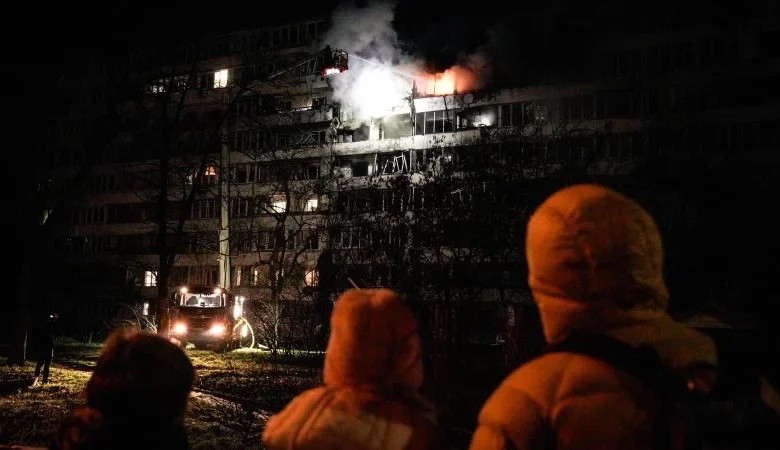Can Trump break the vicious cycle that prolongs the war in Ukraine?

Bullish assessments by US officials are driving President Donald Trump’s latest effort to end the war in Ukraine toward a familiar and inevitable acid test.
Will Russia agree to any deal that Ukraine and its European partners modify to secure their sovereignty and security?
Trump is pining for an agreement — both because he lives for deals and because he’s trying to bill himself as a global peacemaker as he builds a legacy. He has shown he’s not too worried about whether any final pact ends up rewarding the aggressor, Russia, or whether it will leave NATO’s European states fearing further expansionism by the Kremlin.
After a day of hopeful rhetoric from Washington, Trump seemed to confirm the fears of his critics when he appeared to signal Russia would not be required to give much ground in talks to end a war it started with an illegal invasion.
“Well, they’re making concessions. Their big concession is they stop fighting and they don’t take any more land again,” Trump told reporters Tuesday evening.
Since he’s again forcing the situation, with a draft plan that initially read like Russia’s work, Ukraine has no choice but to go along. But Kyiv is trying to nix conditions that would threaten its existence and capacity to defend itself after the war.
European nations are unwilling to alienate Trump, because they depend on him to defend them and to sell them arms for Ukraine. So they had little choice but to follow their usual pattern — praising the president while working to sand down pro-Russia ideas that imperil their own safety. Their suspicions of Moscow are heightened because they blame Russian hybrid warfare for a series of drone intrusions, cyber attacks, sabotage, and tense air and naval encounters.
But as anticipation builds in Washington amid signs Ukrainian President Volodymyr Zelensky will soon visit Trump to discuss an agreement, perennial roadblocks that thwarted past efforts are reemerging.
Can Trump sell a deal that Zelensky can live with to President Vladimir Putin, given Russia’s demands for Ukraine to hand over strategic territory Moscow doesn’t control? Does the Kremlin indeed have any interest in negotiating on a ceasefire or longer-term peace agreement that would limit its efforts to strangle an independent Ukraine? Would any Russian shift in position be genuine, or would it simply be a way to prolong negotiations while Moscow’s forces make front-line advances? This last question is why European states are demanding a ceasefire before a full peace process — a condition that Russian has resisted in previous drives to end the war.
Ultimately, Trump’s newest peace initiative will come down to whether Putin wants to make peace. There has been no sign since he invaded Ukraine more than three years ago that he does. If that doesn’t change, another question will become even more urgent: How long is Trump willing to tolerate this cycle of futility before he walks away entirely — which would represent a victory for Moscow?
The White House expressed great optimism on Tuesday that a deal was within reach after several days of talks in Europe and the Gulf involving Secretary of State Marco Rubio, US Army Secretary Daniel Driscoll and other top officials.
► Trump on Tuesday celebrated “tremendous progress” in fine-tuning his initial 28-point peace plan, which was widely condemned as a Russian wish list. He said he’d directed his envoy Steve Witkoff to go to Moscow to meet Putin. The real-estate specialist turned envoy may get a warm welcome, judging by the transcript of a call he had with a top Putin adviser in October, in which he seemed to be coaching the Russians to flatter Trump to win approval of the Gaza-style peace plan. In the transcript published by Bloomberg News, he seems as much an adviser to the Russian government as to the White House.
But White House communications director Steven Cheung said in a statement that “this story proves one thing: Special Envoy Witkoff talks to officials in both Russia and Ukraine nearly every day to achieve peace, which is exactly what President Trump appointed him to do.”
► Zelensky suggested that European leaders — who’ve acted as a kind of diplomatic bodyguard for him in the past — might be helpful in any meeting with Trump in the US.
► British Prime Minister Keir Starmer said Ukraine could accept much of the US proposal in its current form. But a Ukrainian source with direct knowledge of the talks told CNN’s Matthew Chance that some of the fiercest disputes remain, including on whether Ukraine would give up territory Russia has not conquered; over Moscow’s limit on the size of its postwar military; and on Ukraine renouncing ambitions to ever become a member of NATO. Starmer hinted as much, saying: “Ukraine is holding the line fearlessly. And it’s the line of their sovereignty and their defense.”
► French President Emmanuel Macron, meanwhile, said there would be a US component to proposed European security guarantees for Ukraine after a peace agreement. But Russia has always rejected such proposals, so it’s not clear whether the West is simply negotiating with itself.
Whether there’s progress or only the illusion of it may become clearer over the Thanksgiving holiday.
This White House is prone to trumpet incremental progress as major triumphs for Trump. At one point on Tuesday, a US official said Ukraine had agreed to a deal, only for Kyiv to temper expectations. So it’s best not to judge the prospects for the talks based on the buoyancy of a president who once promised to end the war in 24 hours.
On the other hand, Washington is deploying a time-honored tactic vital to all peace negotiations — conjuring an impression of momentum even if it doesn’t exist to keep hopes alive and to increase the diplomatic costs to either party to walking away from the table.
Trump sent shockwaves across the Atlantic with his initial 28-point proposal. It included Russia’s demands that Ukraine give up land it still holds in eastern regions of Donetsk and Luhansk and a provision that its enemy will never join NATO. His timing seemed like cynical opportunism at a moment of weakness for Zelensky, who is embroiled in a corruption scandal, and as Russian troops make battlefield gains, to impose an unjust end to the war on Ukraine.
But if Trump somehow achieves a breakthrough, it would not be the first time that he’s cracked open negotiations by laying down a maximalist position and threatening to walk. As the leader of the West and a friend of Putin, the US president may be the only force that could shift political calculations.
US officials appear to be trying to implement a similar template to the one that yielded a ceasefire in Gaza between Israel and Hamas, which also started with a long list of proposals that were later refined. But the two scenarios are not the same. Trump was able and willing to apply pressure on Israel to sign up to his plan. The Arab states did the same for Hamas. But Trump seems to lack the leverage or desire to similarly pressure Russia, despite recently imposed US secondary sanctions on Moscow’s oil exports, which keep its war machine running.
Still, the Israel-Hamas ceasefire has held, as fragile as it is, and US officials — including some of those involved in the Ukraine push — have been working diligently to try to initiate a true peace process. Few thought Witkoff and other senior administration officials could pull that off, either.
It has long been accepted in Europe, the United States and even Kyiv that Ukraine will not be able to regain at the negotiating table most of the territory it has lost in the war. But Russian demands for all of Luhansk and Donetsk could be a dealbreaker for Kyiv, since this could position Russian to stage another attack in the future. US proposals seen by CNN suggest the area of Luhansk and Donetsk that is most contested could become a demilitarized zone. But this could still strip Ukraine of its best means of defense against an attack from the east.
Even amid talk of real progress in Europe, deep skepticism remains in Ukraine after days of fresh Russian air attacks.
“Trust me, nobody wants peace more than all of us,” Ukrainian member of parliament Inna Sovsun told Zain Asher on CNN International. But she added, “Frankly speaking, there is not much pressure being put onto Russia. The only concessions that have been debated is, ‘What concessions is Ukraine going to make?’ What are the concessions that Russia is going to make?”
Any ceasefire that involves a freezing of the battleground on the current front lines, plus security guarantees — including a European stabilization force and a US support role — might have a chance. Yet Russia has given no sign it has dropped objections to such conditions. And no one on the European side of the Atlantic trusts Putin.
And some gaps might be unbridgeable.
Zelensky said Tuesday “the principles” of the US document can be further developed into deeper agreements. But the more a proposal is refined to please Zelensky and Europe, the further it moves from Moscow’s maximalist position.
Democratic Sen. Chris Van Hollen, who sits on the Foreign Relations Committee, explained the stakes on “CNN News Central” on Tuesday. “It was a Russian-tilted plan. And so, of course, the Ukrainians and our European allies resisted it. And now … (there were) these discussions in Geneva where apparently the Ukrainians and the Americans are now kind of on the same page. It’s gone from 28 points to 19 points. But if you’re Russia, you’re going, ‘Hey, I’ll take that original Trump plan, right?’”
That is the critical sticking point. And there’s no sign it’s changed.
Unless Putin is facing political and economic strains not evident from the outside, Russia may be in a “heads, I win; tails, you lose” situation.
If it can wrest diplomacy back toward its goals, possibly with Trump’s help, it might contemplate ending the war — for now — on its terms. If its intransigence breaks this latest initiative, it can keep fighting — which it may want to do anyway. Any subsequent recriminations between the US and Europe will further one of its overarching goals: pulling Trump further away from the Western alliance.
Something is needed to change the vicious cycle.





